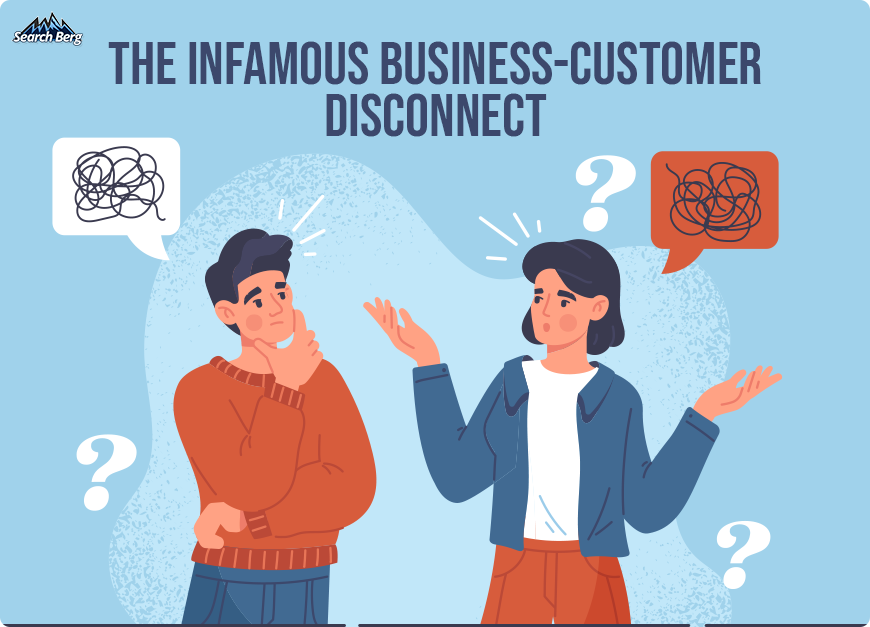The Importance of a Website for Small Businesses

Times are changing.
In 2024, a potential customer won’t ask you where your business is located. Instead, they’ll politely ask for your website URL.
And if you don’t have one to offer, well, that potential customer will end up turning into a loss for you and a win for your competitors.
The statistics cannot be ignored. In 2023, 2.64 billion people shop online. In 2024, this number will reach 2.71 billion. And by 2025, we’re looking at 2.77 billion online shoppers.
If you still haven’t set up a website for your small business, you’re waving a big chunk of potential customers goodbye before they even get a chance to notice your presence.
A well-designed, well-developed, and audience-friendly website is your golden ticket to a stellar online presence, high rankings, enviable traffic, roaring conversions, and profit that makes your competitors green with envy.
A small business website is, indeed, one of the first boxes to check off the list if you’re aiming for a successful business that grows instead of stagnating.
Are you with us?
We’re glad.
Our latest blog offers a deep dive into the importance of a website for small businesses in 2023–24. We’ll answer some of the most pressing questions presented by small business owners and help you take action, i.e., launch that engaging, responsive, and interactive website you’ve been wanting to get off the ground for a while now.
Let’s begin!
1. A Closer Look at the Current Digital Landscape
The business landscape is as dynamic and ever-changing as the latest Twitter trend.
For small businesses, this online ecosystem isn’t just a vast expanse to navigate; it’s a thriving marketplace bustling with opportunities and challenges.
First off, let’s talk numbers, because they don’t lie. With over 5.3 billion active internet users worldwide, the digital world is like a colossal global bazaar.
If you run a local small business in Houston, your potential customer could be sitting in a cozy café in Sugar Land or on a subway in Friendswood.
If you run a national small business in the U.S., your potential customer could be attending a meeting in New York or enjoying their child’s football game in Florida.
And if you run an international small business, your potential customer could be working remotely from a beach in Bali or exploring historical landmarks in Rome.
This means your small business has the potential to cross neighborhoods, towns, cities, states, countries, continents, time zones, and cultural barriers.
Wow.
But only if you have an online presence starting with a small business website.
Now, consider the competition. It’s fierce, and it’s global. Your competitors aren’t just other local shops; they’re businesses from all corners of the world.
A well-crafted small business website acts like your business’s battle armor in this competitive arena. It’s where you showcase your unique brand story, products, and what sets you apart. Without it, you’re like a knight stepping into battle without a shield, vulnerable and unseen.
The shift in consumer behavior adds another layer to this narrative. Online shopping and information-seeking have become reflexive actions.
Customers expect to find what they need online, and if they don’t find you, they’ll definitely find someone else. That’s the harsh reality. A small business website helps you meet your customers where they are: online.
But there’s more to the digital landscape than just setting up shop. It’s about being found. This is where the magic of SEO comes into play (more on this later).
And let’s not forget the power of data! A website isn’t just about broadcasting your message; it’s a goldmine of insights. Through website analytics, you can understand who your customers are, what they want, and how they interact with your brand. This information is gold dust for tailoring your products, services, and marketing efforts.
2. The Risks of Staying Offline

Let’s talk straight.
Staying offline in the modern business world is like showing up to a potluck with empty hands. You’re there, no doubt about it, but you’re not contributing or benefiting from the feast.
It’s a bold move, but not necessarily a wise one, especially when everyone else is dishing out their best online offerings.
For small businesses, the internet is the grand banquet of opportunities, and not participating may leave you hungry for success. This isn’t fear-mongering; it’s just a matter of being realistic and understanding the importance of websites in business.
Staying offline doesn’t just mean you’re playing hard to get with your potential customers; it means you may not be playing the game at all. Let’s break down what this means for your business.
2.1. Invisible to the Digital Consumer
If you don’t have a small business website, you’re essentially a ghost business to the digital consumer.
These consumers, armed with smartphones and a propensity to research before they buy, will likely never stumble upon your offerings. Instead, they’ll walk straight into the welcoming arms of your competitors who have set up shop in the digital world.
Let’s say you’re a local artisanal coffee roastery. Without a website, how will the discerning coffee enthusiast, who spends their evenings browsing the internet for the next best brew, find out about your exotic Ethiopian beans?
They won’t just magically know you exist. They’ll end up at another roastery’s site, one that’s just a few clicks away, and order their beans there.
Being invisible to the digital consumer doesn’t just mean missed direct sales. It translates to missed opportunities for brand discovery, customer loyalty, and word-of-mouth marketing that could have sparked from that one online encounter.
Your digital absence effectively hands over your portion of the market to others who are visible and reachable online. This is why websites are so important for business.
2.2. Limited Market Reach

When we talk about “limited market reach” for small businesses without a website, we’re spotlighting a big misstep in today’s market dynamics.
Without a website, you won’t just reach fewer people; you’ll miss the vast ocean of customers outside the physical radius of your brick-and-mortar location. This limitation can be a critical hindrance to small business growth.
Consider, for instance, a boutique that specializes in eco-friendly clothing. Located in a small town, its homemade products have the potential to charm eco-conscious consumers nationwide (even globally). However, without a small business website, the boutique’s reach is confined to locals and the occasional tourist. The broader audience, actively searching online for sustainable fashion, remains untapped.
Competitors with online stores capture this market. They cleverly leverage their digital presence to serve customers far beyond their physical locality.
This scenario highlights a key point: the internet has dramatically altered how businesses access and engage with their market. It’s no longer about waiting for customers to pass by your shop; it’s about reaching out to them wherever they are.
A website acts as a bridge; it connects your local business to a global audience and breaks down geographical barriers. The outcome? You can expand your customer base beyond the constraints of location.
Limited market reach also impacts scalability. Businesses often seek to grow and evolve, but without a website, scaling up becomes a challenge.
An online presence provides the flexibility to explore new markets, test different audiences, and adapt to changing consumer trends without the significant overheads of physical expansion. See why websites are important?
2.3. Missed Opportunities for Brand Building
Let’s say you run a family-owned hot sauce business. You’ve honed your recipes over generations; each bottle is a testament to your heritage and passion for flavor.
But here’s the catch: without a website, this rich story remains largely untold, confined to the labels on your bottles and the customers who already know you. It’s a missed opportunity to build a brand that resonates emotionally with a wider audience and turns casual buyers into loyal brand advocates.
In the context of brand building, a small business website is a powerful tool. It’s where visual identity, messaging, and customer experience converge to create a lasting impression.
It’s an opportunity to differentiate yourself from the competition, showcase your expertise, and build trust. In its absence, small businesses forfeit the chance to shape public perception and establish a recognizable brand.
Brand building isn’t just about attracting new customers; it’s about nurturing relationships. A website allows for ongoing engagement with your audience; you get a chance to keep them updated with the latest products, stories, and developments.
This engagement fosters a sense of community and loyalty (which is invaluable for small businesses competing in a crowded marketplace).
2.4. Neglecting Customer Expectations and Engagement

Modern consumers aren’t just tech-savvy; they’re tech-dependent. They understand the importance of web presence and expect to interact with businesses online just as naturally as they do in physical stores. Without a website, you’re off the grid.
For instance, let’s say you own a charming café known for its artisanal blends and cozy ambiance.
In the pre-digital era, word-of-mouth and the aroma wafting down the street may have been enough to lure customers in. Fast forward to today, where people first browse online for the “best coffee near me” before stepping out.
Without a small business website, your café misses the chance to entice these potential customers with tantalizing images of your latte art or glowing reviews of your serene atmosphere. You’re not part of their digital decision-making journey, and thus, not an option in their café-hopping adventures.
This scenario illustrates more than just lost sales; it’s a clear example of why websites are important for business. You fail to meet customers in their comfort zone: the digital space.
A small business website is a platform for engagement. It gives businesses the opportunity to connect with customers, receive feedback, and keep them updated on the latest offerings, events, or changes.
It’s also where customer service shifts into high gear. You provide answers to questions, resolve issues, and ensure complete satisfaction. Customer service isn’t just about face-to-face interactions anymore; it’s about being available and responsive online (where many customers now prefer to communicate).
And let’s not forget that neglecting digital engagement also means losing out on invaluable insights into customer behavior. A small business website, as part of a power-packed website design and development package, can offer analytics on which products or services attract the most interest, the demographics of your visitors, and how your audience interacts with your content.
This data is gold dust for tailoring your offerings to what your customers really want.Top of FormBottom of Form
3. How Will a Website Benefit My Small Business?
By now, you should have a good understanding of how the absence of a website can affect your business. But once you do end up getting the ball rolling, how exactly will a website benefit your small business? Let’s find out.
3.1. Enhanced Visibility and Online Presence
When we talk about “visibility,” we’re not just talking about mere online existence; we’re talking about actively participating in a space where your customers live, work, and make purchasing decisions. A website plays a pivotal role in achieving this visibility.
Take search engine visibility, for instance. It’s a game-changer for small businesses. When your business pops up in Google searches, it’s essentially appearing in front of people who are actively searching for what you offer.
A local bakery’s website optimized for search terms like “best birthday cakes in Miami” becomes a magnet for customers in that area seeking those exact services. This targeted visibility is powerful and can level the playing field against bigger competitors.
A small business website also opens doors to a broader audience. While a physical storefront limits you to foot traffic and local customers, a website breaks down geographical barriers. This is especially beneficial for niche businesses whose specific products or services may have a scattered customer base.
Integration with platforms like Google Business Profile (previously known as Google My Business) amplifies this effect. It’s not just about being on the map; it’s about being easily accessible when local customers are searching for related services. This integration boosts both your search engine and local visibility.
Then there’s the synergy between your website and social media. This integration is a potent tool for enhancing your online presence.
Every piece of content you share and every interaction on your social platforms can drive traffic back to your website. The result? A cycle of engagement and visibility is created. This is precisely why websites are important for business.
Additionally, the importance of content marketing cannot be overstated. A small business website rich in engaging content attracts more visitors and establishes your business as a thought leader in your industry. This content becomes a resource; it’s a reason for customers to visit and revisit your site. Each revisit helps build familiarity and trust in your brand.
Your website is also a data powerhouse behind the scenes. With analytics, you can understand who your customers are, what they want, and how they interact with your online presence. These insights enable you to fine-tune your marketing strategies. It’s a great way to ensure that you’re not just visible but also resonating with your target audience.
Lastly, the digital advertising realm is vast and varied, and having a small business website allows you to tap into it. Whether it’s through Google Ads, social media advertising, or other digital platforms, you can direct traffic to your website and further increase your business’s reach.Top of FormBottom of Form
3.2. Direct Sales and eCommerce Opportunities

Setting up a small business website is a great way to put your products/services in the fast lane of commerce, available 24/7, rain or shine.
Take, for instance, a local winery. Traditionally, they may rely on tasting room sales and local events to sell their wines.
By pivoting to a website with eCommerce capabilities, they’re no longer just a weekend destination; they’re in homes across the country, one click away from someone planning their next dinner party. Sales aren’t bound by opening hours, and customers don’t need to be within driving distance.
This leap into eCommerce isn’t just about boosting sales; it’s about redefining the very way small businesses operate. Inventory can be managed in real-time, sales analytics can shape future production, and customer feedback can be harnessed directly to refine offerings. This is why the importance of webpages cannot be ignored.
And let’s not forget that the marketing possibilities are endless! Email campaigns can retarget customers, social media can drive promotions, and online exclusives can create buzz.
For small businesses, an online sales platform means the ability to scale up without the proportional increase in overheads that comes with physical expansion. It’s about doing more with what you have, reaching out further, and tailoring your operations based on direct customer interactions and data.
However, there’s a catch. eCommerce success doesn’t just come from setting up shop; it comes from crafting an experience.
The most successful small business websites understand that online customers expect convenience, ease, and security. They ensure their sites are user-friendly, checkout processes are smooth, and customer service is just a chat away.
The transition to online sales opens a business up to a different competitive landscape. Suddenly, you’re vying for attention in a vast marketplace. This is where small businesses can carve out their niche, highlight what makes them unique, and capitalize on the personal touch they can offer that big-box competitors often cannot.
3.3. Increased Credibility
The modern consumer’s skeptical gaze shouldn’t be undermined. In a world where trust is as valuable as currency, a business’s credibility is often gauged by its digital footprint.
Customers assume that a legitimate business will have a website (just as they would a physical address or a phone number). The absence of a website can raise eyebrows and lead to questions about a business’s legitimacy or longevity.
Let’s say a web user is looking for a local plumber. They come across two options: one has an informative website detailing services, prices, and glowing customer testimonials. The other has no website; you’re left with a phone number scribbled on a local bulletin board.
The choice becomes a no-brainer. The plumber with the website is perceived as more trustworthy simply because they have taken the time to establish an online presence that provides transparent information and social proof.
A website also allows small businesses to control their narrative. It’s a place to tell your story, share your business journey, and articulate your business values and mission. This openness is a cornerstone of credibility; you’ll get a chance to build a rapport with customers before they even walk through your door or make a purchase.
A professional-looking website signals that a business is serious, invested, and here to stay. It reassures customers that the business isn’t a fly-by-night operation but a committed player in the market. It shows that the business cares about its image and, by extension, its customers.Top of FormBottom of Form
For businesses aiming to carve out a niche in the digital domain, website design services are invaluable. Try to collaborate with website designers who aren’t just creative but also strategic thinkers; they should be capable of bringing your digital vision to life.
3.4. Competitive Edge in the Market

In the boxing ring of business, a small business website is your one-two punch, giving you a competitive edge in the market. In a world where consumers wield their smartphones like swords, ready to duel with the nearest search query, a website is your shield and armor.
A website does more than just announce your presence. It gives you a platform to showcase what makes your small business unique.
Let’s take the example of a local artisan cheese shop. With a website, they’re no longer a whisper down the lane; they’re a global conversation. They can share their farm-to-table stories, organic certifications, and community involvement (all of which resonate with today’s conscientious consumers).
But it’s not just about looking good. It’s about being found. A website with the right SEO tactics draws in traffic that’s not just high in volume but also high in quality. This targeted visibility is the kind of competitive edge that turns small businesses into market contenders.
A website also acts as a springboard for innovation. It allows for the implementation of new technologies like AI chatbots that provide personalized customer service or augmented reality that lets customers ‘try’ products before purchasing.
These are the kind of cutting-edge experiences that were once the exclusive domain of big-budget businesses but are now within reach for the nimble and savvy small business owner.
In the race for market share, a website also provides an invaluable feedback loop. Through customer interactions, reviews, and analytics, you gain insights that can inform product development, marketing strategies, and customer service improvements. This continuous loop of learning and adapting can keep a small business several steps ahead of the competition.Bottom of Form
4. What Are the Qualities of a Good Small Business Website?
A good small business website isn’t just a digital placeholder; it’s the digital incarnation of your business ethos, philosophy, and customer service.
It’s where first impressions are crafted, and the seeds of customer relationships are sown.
So, what makes a top-notch small business website stand out from the digital pack?
4.1. Streamlined User Experience

What’s at the core of a good small business website? User experience (UX) that’s as smooth and inviting as the first sip of morning coffee. It’s the digital equivalent of a well-organized shop where everything is within easy reach, and you can find what you’re looking for without a map.
User experience dictates how visitors interact with your content, products, and services.
Stellar UX begins with navigation that’s as clear and straightforward as your favorite cookbook. The menus should be organized logically and must guide visitors through your site with intuitive ease. Web users shouldn’t have to click more than a few times to find what they’re looking for (whether that’s your product listings, service descriptions, or contact information).
Clear calls-to-action (CTAs) are the signposts that direct customers on what to do next. Whether it’s ‘Buy Now’, ‘Learn More’, or ‘Get in Touch’, these prompts are the bold, clear, unmissable buttons that help users take the desired action. They’re like the friendly nudges that say, “This way to the next step.”
And when it comes to the path to purchase or inquiry, the road should be as smooth as a freshly paved highway. This means eliminating any roadblocks that could cause frustration or abandonment.
The checkout process should be simple; only ask for essential information and provide reassurance with each step. It should also offer multiple secure payment options to cater to a variety of preferences.
4.2. Responsive Design
In the sprawling digital landscape, where devices come in all shapes and sizes, a small business website must be a chameleon: adaptable and ready to present itself perfectly across the board.
We’re don’t just mean it should look good; it should also function at the peak of usability irrespective of the screen size.
Let’s break it down. With responsive web design, you’re not just throwing a wide net hoping to catch any device that swims by. You’re meticulously crafting a net that morphs and adjusts to fit whatever comes its way.
Whether it’s a smartphone held on a crowded subway, a tablet perched on a kitchen counter, or a desktop computer in a home office, your website should offer the same clarity, ease, and access to every device.
This adaptability is imperative. It means that when someone stumbles upon your small business website while searching on their phone, they won’t be greeted with tiny text and impossible navigation that requires the fingers of a fairy to operate. Instead, they’ll find a site that’s as navigable and legible as if they were on their full-sized computer.
Think about it.
No one enjoys squinting at their phone, pinching the screen to zoom in and out, or tapping the wrong link because everything is too cramped. These are the digital equivalents of minor annoyances that can sour a customer’s experience with your brand.
Responsive web design eliminates these by fluidly transforming your site to fit any device’s virtual real estate. The outcome? Frustration is never part of the user journey.
Let’s keep in mind that responsive design isn’t just about customer satisfaction; it’s also smart business. Search engines like Google prioritize mobile-friendly websites in their rankings. In the eyes of these digital gatekeepers, a responsive website is a mark of quality and relevance.
By ensuring your site is responsive, you’re also boosting its potential to climb up the search engine result page (SERP) ladder, bringing more eyes and more business to your digital doorstep.
Instead of taking the reins yourself, which may sound tempting, opt for responsive web design services. Look for a website design company that understands your industry’s nuances and your small business’ unique requirements.
Experienced website design service providers will collaborate with you to ensure that your brand’s personality shines through every aspect of your site. They should be adept at creating a seamless experience for your users (irrespective of the device they use).
When searching for web designers, focus on their portfolio and past work. This can give you a clear idea of their design style and technical expertise. It’s also essential to find a team that prioritizes communication and transparency. You want a partner that keeps you in the loop at every stage of the design process and values your input as much as their own.
4.3. Quality Content

Quality content on a small business website is the currency that buys customer interest, trust, and engagement. It’s the equivalent of a firm handshake or a warm welcome as customers enter your store.
High-quality content doesn’t just fill space on a webpage; it communicates, persuades, and often entertains. It ensures that visitors don’t just stay on your site longer but also return for more.
In the digital realm, content is the voice of your small business. It’s there to tell your story, explain why your grandma’s secret recipe makes your cupcakes the best in town, or highlight why your handcrafted leather goods are worth the extra penny.
It’s not just about what you say but rather how you say it. Your words should reflect the uniqueness of your brand (whether it’s professional, quirky, or downright revolutionary).
But let’s get down to brass tacks.
Quality content isn’t just well-written prose or catchy slogans. It’s structured, strategic, and SEO-savvy. It knows how to play the game by the rules of the mighty search engines without sounding like a robot.
It’s packed with the keywords that your customers are typing into search bars but woven in so naturally that they’d never know they were anything but casual conversation!
Quality content is also fresh and updated regularly; it gives your customers and search engines a reason to keep coming back. It’s the daily special on the menu, the new item in the window, and the limited-time offer that keeps things exciting. This kind of dynamic content strategy boosts your SEO and keeps your audience engaged.
Ah, and credibility. Articles, blogs, and guides that offer valuable insights position your business as an authority in your field. When customers see that you know your stuff, they’re more likely to trust you with their business. And trust is the foundation upon which customer loyalty is built.
Content isn’t just text. It’s videos that show your product in action, images that tell a story at a glance, and infographics that turn data into digestible bites. It’s a multi-layered approach that caters to your audience’s diverse preferences.
Quality content is also responsive. It listens to the audience, adapts to feedback, and continually evolves. It’s the kind of content that answers questions before they’re asked and solves problems the customer didn’t even know they had. It’s proactive, intuitive, and, above all, what turns a browser into a buyer.
If you want to invest in quality content, don’t take shortcuts. Opt for a comprehensive albeit affordable website design and development package that comes with content planning, writing, editing, optimization, and marketing.
This additional service isn’t always a part of small business web design services. Take your time, look around, and find a team of expert website designers who also wear the content hat (and wear it well).
Recommended Read: The Role of SEO in Modern Web Design: How to Dominate SERPs
4.4. Fast Load Times
We may sound like a broken record, but this needs to be said as much as possible: time is currency. Your website’s loading speed can be the deciding factor between a sale and a fail.
Fast load times don’t just give you an edge; they’re absolutely necessary. They respect your visitor’s time and directly impact their experience and your website’s overall performance. Slow-loading pages are the online equivalent of long queues at the checkout line; they test patience, and in the online world, patience is in short supply.
Speed is a silent salesman. It operates in the background, unseen, yet it is one of the most persuasive factors in keeping visitors on your website.
Consider this. A delay of mere seconds in page response can result in a significant drop in conversions. Visitors are quick to close tabs and move on to a competitor if a website dawdles and takes its own sweet time to reveal what they came for.
This need for speed isn’t just about user impatience. Search engines, particularly Google, place a premium on page loading times when ranking websites. A snappy website is more likely to climb search engine results pages (SERPs), earn high visibility, and become accessible to potential customers.
This is where your website’s technical prowess comes into play. Optimized images, streamlined code, and reliable hosting all contribute to the brisk pace of your website’s performance.
But fast load times aren’t solely the domain of the tech-savvy. They’re a reflection of your business’s understanding of customer needs and expectations.
A small business website that loads quickly demonstrates that you value your customers’ time and that your business operates at the pace of modern life. It’s an assurance to your customers that you’re committed to providing them with not just great products and services but also a great online experience.
The benefits of fast-loading pages extend beyond the front end. They can reduce bounce rates, increase engagement, improve user experience, and strengthen your website’s ability to retain visitors.
When web pages pop up promptly, visitors are more likely to explore further, delve deeper into your content, and, most importantly, make a purchase.
In eCommerce, where every second counts, the speed at which your website operates can be directly correlated to revenue.
Online shoppers have a need for speed; catering to this need can significantly boost your sales. It’s about capturing and holding the fleeting attention of potential customers long enough to convince them of the value of your offerings.
4.5. Robust Security
Small business website security is the digital equivalent of a top-notch alarm system in a brick-and-mortar store.
At a time when cyber threats loom large, it’s your responsibility to ensure your website is secure. This isn’t just about protecting your data; it’s about safeguarding your business’s reputation and your customers’ trust.
Consider the fallout from a security breach: sensitive information compromised, hours of operation disrupted, and hard-earned customer trust evaporating in an instant. The internet is a neighborhood where digital burglars are always on the lookout for an easy score. A website without robust security is like leaving the door to your shop unlocked after hours.
A small business website fortified with strong security measures tells customers that you take their safety seriously. It’s a statement that their personal and payment information is encrypted.
Implementing security protocols like SSL certificates is one of the fundamental steps in building this trust. When customers see that padlock icon next to your URL, they breathe easier, knowing their data isn’t up for grabs.
But robust security isn’t just about the customer; it’s also about continuity. A secure website is less likely to suffer from downtime caused by hacking or malware.
For small businesses, which may not have the resources to bounce back quickly from such disruptions, this can be the difference between staying afloat or sinking.
Website security is also a cornerstone of professional credibility. It positions your business as reliable and establishes you as a serious player in the digital marketplace. It shows foresight and responsibility—qualities that customers look for when deciding who to do business with.
5. Bottom of FormGlobal-marketing Inc.: Your Digital Helping Hand

By now, you know that websites are important. You know how a website can benefit you, how the lack of a website can hurt your business, and the right way to get started.
Where does this lead you?
Straight to Global-marketing Inc..
We’re not just another digital marketing agency in the business; we’re an award-winning firm with over 10 years of experience in SEO and web design.
When you approach us for web design and development, we won’t just craft a one-size-fits-all website and call it a day. We’ll take the time to understand your business model, industry, target audience, unique selling propositions, and competitors. This information will be used to plan, design, write, develop, optimize, and launch a website that resonates with and converts your target audience.
Our end goal is simple and straightforward: more business for you. By designing a website that your audience actually likes, enjoys, and appreciates, we help improve your bottom line.
Oh, and we don’t ignore the importance of SEO in small business web design. Yes, we want your audience to enjoy your website, but that’s not all. We also want Google to acknowledge your website and reward it with higher rankings, i.e., better visibility, more clicks, more conversions, and you know the drill.
Our action-oriented approach to web design and development leaves you with results. No big talk, no fluff, no embellishments. Just a targeted, effective, no-nonsense approach that yields what you’ve wanted from day one: results.
Are you ready to get started? Explore our web design and development services to understand how we can help you!
The best part? We start with a free consultation and offer a money-back guarantee, so you don’t have to worry about shelling out coins you won’t get back. Our confidence, experience, expertise, and skillset help us get you from Point A to Point Z with honesty, dedication, and professionalism.
The ball is in your court now!












